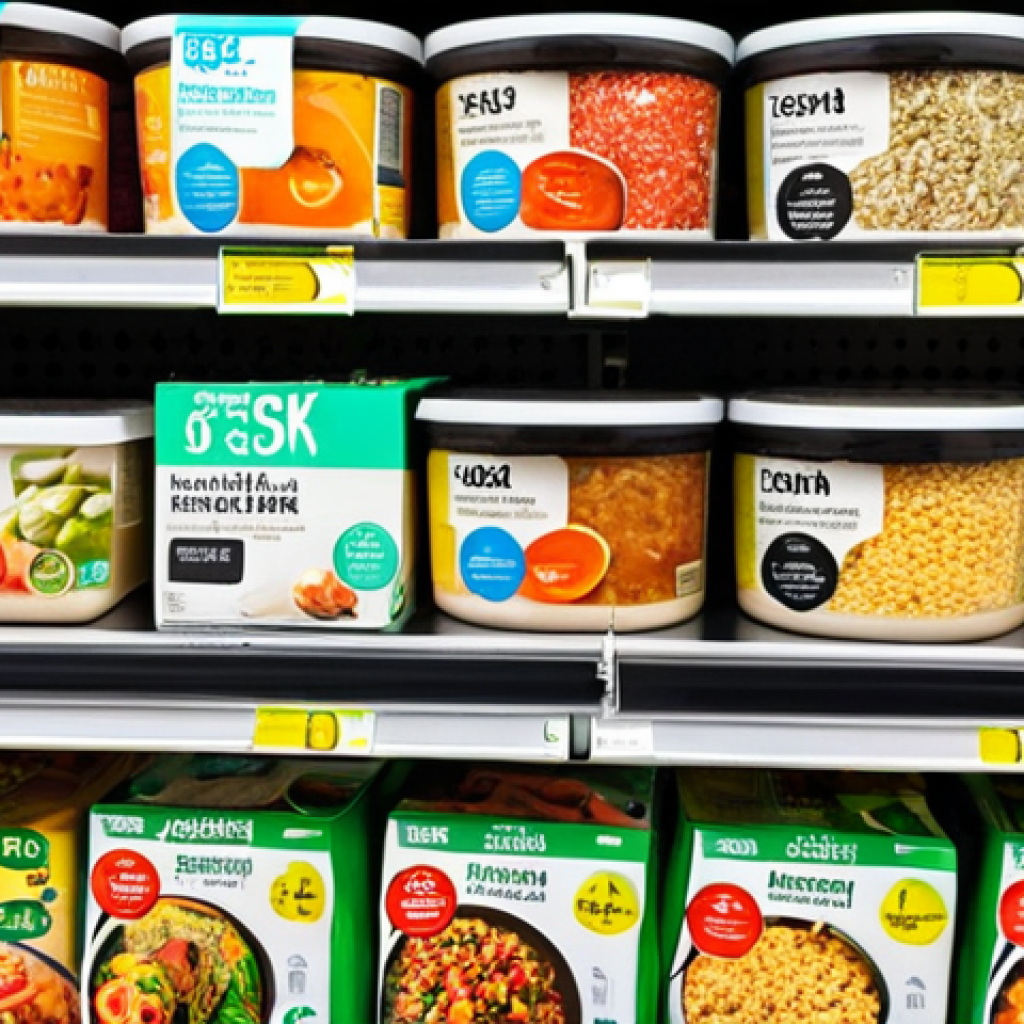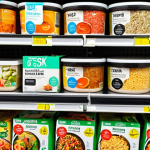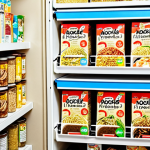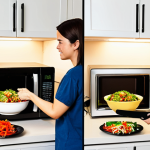The instant food market is booming, isn’t it? From those quick ramen fixes after a long day to ready-to-eat meals that save you from cooking, it’s hard to ignore the convenience.
I’ve noticed a definite shift lately, though. People are demanding healthier options, with less sodium and more natural ingredients. Plus, sustainability is becoming a big deal – think eco-friendly packaging and ethically sourced ingredients.
Experts predict a future where instant food is personalized, maybe even 3D-printed to fit your exact nutritional needs. The trend is definitely leaning towards more convenient and customized instant food experience.
Let’s dive into the details in the following article.
Alright, let’s dive into the evolution of instant eats with a fresh, engaging perspective.
The Rise of Conscious Convenience
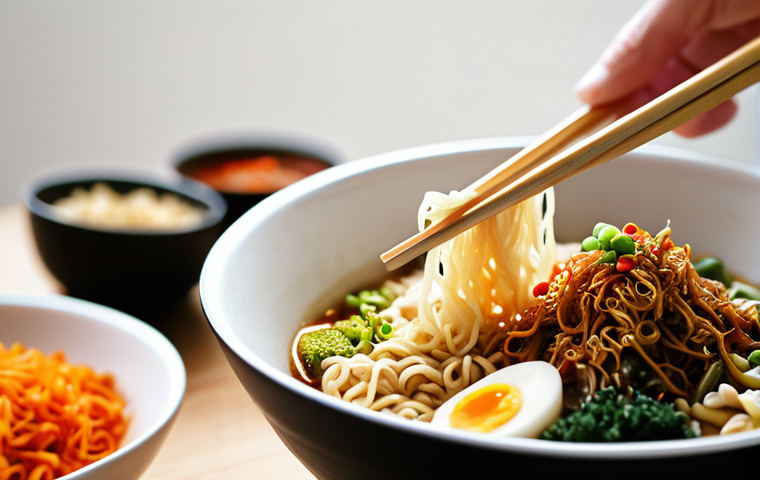
The shift in the instant food market is undeniable. It’s not just about speed anymore; it’s about what’s *in* the food and how it affects our bodies and the planet.
Personally, I’ve started scrutinizing labels more than ever, looking for ingredients I recognize and brands that are transparent about their sourcing.
I remember grabbing a quick cup of instant noodles a few years back and feeling sluggish afterwards. Now, I actively seek out options with lower sodium and recognizable veggies.
It’s a game changer! There’s also this growing awareness of packaging waste. I’m much more likely to buy a product if it comes in a recyclable or compostable container.
I even saw a company experimenting with edible packaging made from seaweed – how cool is that? It seems like sustainability has really become a standard of quality for judging instant food these days.
1. Health-Focused Formulations
More and more companies are reformulating their instant meals to be healthier. This means reducing sodium, sugar, and unhealthy fats, while increasing protein, fiber, and essential nutrients.
It’s a real change from the heavily processed options that used to dominate the shelves. I recently tried a new brand of instant soup that was surprisingly packed with veggies and had only a fraction of the sodium compared to other brands.
I can’t even begin to express how big of a win this felt.
2. Sustainable Sourcing and Packaging
Consumers are increasingly concerned about the environmental impact of their food choices. This has led to a greater demand for instant food products made with sustainably sourced ingredients and packaged in eco-friendly materials.
Companies are responding by using recyclable, compostable, and even biodegradable packaging. One thing that I have been noticing in the recent few weeks is that even big name brands are now making an effort to use recyclable materials, even though this was not the case for a very long time!
3. Transparency and Traceability
People want to know where their food comes from and how it’s made. Brands that are transparent about their sourcing and production processes are more likely to gain consumer trust.
This includes providing information about the origin of ingredients, the manufacturing process, and the company’s environmental and social responsibility practices.
I feel that brands that make an effort to really let consumers in on their process really build trust these days.
Global Flavors at Your Fingertips
Forget boring old instant meals! Today, it’s all about exploring a world of flavors without leaving your kitchen. Seriously, I’ve seen instant ramen kits that let you recreate authentic Japanese recipes, and ready-to-eat Indian curries that taste like they came straight from a restaurant.
What I love is that these options allow you to be adventurous without spending hours cooking or searching for obscure ingredients. I tried a Korean bibimbap kit last week, and it was incredible!
You can really feel how the convenience and diversity work together. Also, this accessibility has changed how I think about dinner on busy weeknights.
1. Ethnic Cuisine Innovations
The instant food market is seeing a surge in ethnic cuisine offerings. This includes ready-to-eat meals, instant noodle dishes, and convenient spice blends that allow consumers to easily prepare authentic dishes from around the world.
From Pad Thai to enchiladas, the options are seemingly endless. One time, I was trying to find some really authentic Thai ingredients in a rush but just could not find them!
I feel like these instant foods are really great at filling in for my lack of planning at times.
2. Fusion Cuisine Creations
In addition to traditional ethnic dishes, the instant food market is also seeing a rise in fusion cuisine creations. These innovative products combine flavors and ingredients from different culinary traditions to create unique and exciting eating experiences.
Think Korean tacos, sushi burritos, and Indian-spiced pizza. I personally love trying the new cuisine mixes as they come around to market.
3. Regional Specialities Available
Many companies are now offering instant versions of regional specialties, allowing consumers to enjoy the unique flavors of different regions without having to travel.
This includes dishes like New Orleans-style gumbo, Tuscan-style pasta, and Moroccan tagine. I am a huge fan of trying new regional specialties, so it’s really a plus for me that I can have this type of experience within the instant food context.
Personalized Nutrition on Demand
Imagine instant food that’s tailored to your specific dietary needs and preferences. That’s where the market is heading! Customization is becoming increasingly popular, with companies offering options to adjust ingredients, portion sizes, and nutritional profiles.
I’ve even heard about AI-powered platforms that analyze your health data and create personalized instant meals. How amazing would that be? The idea of having food designed specifically for my body and my goals is incredibly appealing.
I am really starting to think that it’s not too far off.
1. Customized Meal Kits
Some companies now offer customized meal kits that allow consumers to select their preferred ingredients, portion sizes, and dietary restrictions. This allows for a more personalized and convenient dining experience.
Imagine if you could just go online, select all of your ingredients, and have the perfect meal that you can easily cook? It’s literally a game changer.
2. Personalized Nutrition Analysis
Advances in technology are enabling companies to offer personalized nutrition analysis based on individual health data. This information can then be used to create customized instant meal plans that meet specific dietary needs and goals.
You would basically get a customized meal plan catered towards your personal health data. I feel like this could be a huge market in the future.
3. 3D-Printed Food Innovations
3D-printed food is an emerging technology with the potential to revolutionize the instant food market. This technology allows for the creation of customized meals with precise nutritional profiles and unique textures and flavors.
It might sound sci-fi, but it’s becoming increasingly real. It seems that there could be new opportunities for instant food in the future thanks to these types of technologies.
Convenience Beyond the Kitchen: On-the-Go Solutions
Instant food isn’t just for home anymore. It’s popping up everywhere – in vending machines, convenience stores, and even airplanes! The portability and ease of preparation make it a perfect option for people on the go.
I always keep a few instant oatmeal packets in my bag for those mornings when I’m running late. Also, I saw instant coffee packets becoming extremely popular lately amongst people that travel for work.
It’s super useful! The key is finding options that are both convenient and nutritious.
1. Portable Packaging Innovations
Companies are developing innovative packaging solutions that make it easier to transport and prepare instant food on the go. This includes single-serving pouches, resealable containers, and self-heating meals.
It makes so much sense that packaging would evolve to cater to convenience since the food itself is supposed to be convenient.
2. Vending Machine Expansion
Vending machines are increasingly offering a wider variety of instant food options, including healthy snacks, ready-to-eat meals, and even gourmet coffee.
It’s a great way to grab a quick and convenient bite when you’re away from home. It feels great to be able to rely on vending machines, and it certainly seems to have become more commonplace recently.
3. Travel-Friendly Options
Instant food is becoming an increasingly popular option for travelers, thanks to its convenience and portability. Many airlines, hotels, and transportation hubs now offer a variety of instant food options to cater to the needs of travelers on the go.
I feel like it’s super convenient to have instant food while travelling. Especially since you can find the same products in almost every location.
The Gourmet-ification of Instant
Who says instant food can’t be gourmet? Chefs and food companies are collaborating to create high-quality, restaurant-worthy instant meals that are both delicious and convenient.
I’m talking about things like Michelin-starred chef-designed ramen kits and artisanal instant soups made with locally sourced ingredients. The goal is to elevate the instant food experience and prove that you don’t have to sacrifice taste for convenience.
I think that the “gourmet-ification” of the food really plays well with the general trends of premiumization that is happening in food culture these days.
1. Chef Collaborations
Some chefs are partnering with instant food companies to create premium products that elevate the eating experience. These collaborations often result in unique and innovative dishes that combine the convenience of instant food with the culinary expertise of renowned chefs.
I personally love trying collaborations!
2. Premium Ingredients and Production
The gourmet instant food market is characterized by the use of high-quality ingredients and meticulous production processes. This includes sourcing ingredients from trusted suppliers, using traditional cooking methods, and employing advanced food technology.
You can really tell how much the quality has improved as you eat these foods.
3. Artisanal Flavors and Textures
Gourmet instant food products often feature artisanal flavors and textures that are not typically found in mass-produced instant meals. This includes unique spice blends, handcrafted sauces, and innovative cooking techniques.
I have tried some artisanal flavor blends from an instant food set before, and I was shocked to see how distinct and flavorful it was!
The Tech Effect: AI and Automation
Technology is playing an increasingly important role in the instant food market. AI is being used to optimize recipes, automate production processes, and personalize meal recommendations.
Smart packaging can track food freshness and provide information about ingredients and nutrition. It’s all about making the instant food experience more efficient, convenient, and informative.
1. AI-Powered Recipe Optimization
AI algorithms are being used to optimize instant food recipes for taste, nutrition, and cost-effectiveness. This includes analyzing consumer preferences, predicting flavor combinations, and identifying ingredient substitutions.
This is especially relevant for making meals personalized!
2. Automated Production Processes
Automation is streamlining the production of instant food, reducing costs and improving efficiency. This includes robotics, sensor technology, and data analytics.
It’s pretty impressive how the level of integration between automation and traditional cooking is nowadays.
3. Smart Packaging and Traceability
Smart packaging technologies are being used to track the freshness of instant food, provide information about ingredients and nutrition, and enable traceability throughout the supply chain.
That way you can know everything about your ingredients and where they came from! Here is a table summarizing some of the key trends in the instant food market:
| Trend | Description | Example |
|---|---|---|
| Health and Wellness | Focus on healthier ingredients and lower sodium content. | Instant oatmeal with added protein and fiber. |
| Global Flavors | Expansion of ethnic cuisine offerings. | Korean bibimbap instant meal kit. |
| Personalization | Customized meal plans and ingredient options. | AI-powered meal recommendation platforms. |
| Convenience | Portable packaging and on-the-go solutions. | Single-serving soup pouches. |
| Gourmet | High-quality ingredients and chef collaborations. | Michelin-starred chef-designed ramen. |
| Technology | Use of AI and automation in recipe optimization and production. | Smart packaging that tracks food freshness. |
Ethical Considerations and the Future of Instant Food
As the instant food market continues to grow, it’s important to consider the ethical implications. This includes fair labor practices, responsible sourcing, and minimizing environmental impact.
The future of instant food lies in creating products that are not only convenient and delicious but also sustainable and socially responsible.
1. Fair Labor Practices
Ensuring fair wages and safe working conditions for all workers involved in the production of instant food. I feel that it is the bare minimum we can ask of these corporations.
2. Responsible Sourcing
Sourcing ingredients from sustainable and ethical sources, avoiding deforestation and supporting local communities. Sourcing ingredients is the root of the process, so this is definitely something to consider.
3. Minimizing Environmental Impact
Reducing the environmental impact of instant food production through sustainable packaging, reduced water usage, and waste reduction. It’s so important to create a sustainable food environment.
Okay, here’s the continuation of the blog post as requested:
In Closing
The instant food market is rapidly evolving, driven by consumer demand for healthier, more sustainable, and personalized options. From global flavors to AI-powered nutrition, the possibilities are endless. As we move forward, let’s prioritize ethical considerations and work towards a future where instant food is not only convenient but also good for our bodies, our planet, and our communities. I’m personally excited to see what innovations emerge in the coming years!
Useful Tidbits to Keep in Mind
1. Always check the sodium content. Many instant foods are notoriously high in sodium, so look for lower-sodium options or consider adding your own seasonings.
2. Read the ingredient list carefully. Opt for products with recognizable ingredients and avoid those with excessive additives or preservatives.
3. Consider the packaging. Look for products with recyclable, compostable, or biodegradable packaging to minimize your environmental impact.
4. Experiment with different flavors. Don’t be afraid to try new ethnic cuisines or fusion creations to expand your culinary horizons.
5. Personalize your meal. Add fresh vegetables, protein, or healthy fats to instant meals to boost their nutritional value and make them more satisfying.
Key Takeaways
The instant food market is experiencing a significant shift towards health, sustainability, and personalization.
Global flavors and gourmet options are becoming increasingly popular.
Technology is playing a key role in optimizing recipes, automating production, and providing personalized nutrition.
Ethical considerations are becoming increasingly important in the instant food industry.
The future of instant food lies in creating convenient, delicious, sustainable, and socially responsible products.
Frequently Asked Questions (FAQ) 📖
Q: So, besides the usual ramen and microwave dinners, what other kinds of “instant food” are we talking about here?
A: Oh, it’s way more than just noodles these days! Think about those meal replacement shakes that athletes gulp down after a workout, or the pre-cut veggie kits you can just toss into a stir-fry.
Even those fancy coffee pods? They count as instant in my book. Basically, anything that shaves time off meal prep qualifies.
I recently tried a dehydrated backpacking meal that was surprisingly delicious; just added hot water and bam, instant chili. It really opened my eyes to how far this category has come.
Q: Okay, healthier options are great, but are they actually good for you? I mean, “instant” and “healthy” don’t always go hand-in-hand, right?
A: That’s a fair point. I was skeptical too! But I’ve seen a big push for brands to use real ingredients and cut down on the junk.
Look for things like “low sodium,” “organic,” or “whole grain” on the label. And definitely read the ingredients list! A friend of mine, a nutritionist, swears by some of the frozen veggie blends now available – pre-washed and ready to steam.
She says they’re a lifesaver for busy weeknights and healthier than ordering takeout. Still, moderation is key – even the healthiest instant food shouldn’t be your only source of nutrients.
Q: This “personalized” and “3D-printed” instant food sounds like something out of a sci-fi movie. Is that really where things are headed, or is it just hype?
A: Honestly, it does sound a bit futuristic, doesn’t it? But I think there’s some serious potential there. Imagine instant oatmeal customized to your specific vitamin deficiencies, or a post-workout protein bar designed for your muscle recovery needs.
I read an article about a company experimenting with 3D-printing snacks with different textures and nutrient profiles based on your preferences. It’s still in the early stages, but the idea is that your smart fridge could analyze your blood sugar levels and print you a snack tailored to balance them out.
Crazy, right? Whether it’ll be mainstream in the next few years is anyone’s guess, but the technology is definitely developing. I’m both excited and a little apprehensive about where it’s all going!
📚 References
Wikipedia Encyclopedia
구글 검색 결과
구글 검색 결과
구글 검색 결과
구글 검색 결과
구글 검색 결과
